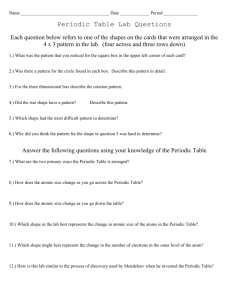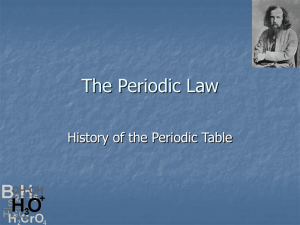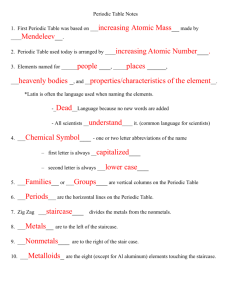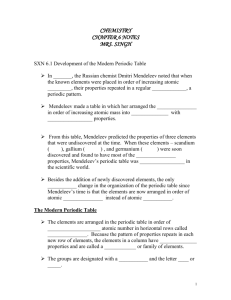Medeleevs Reading
advertisement
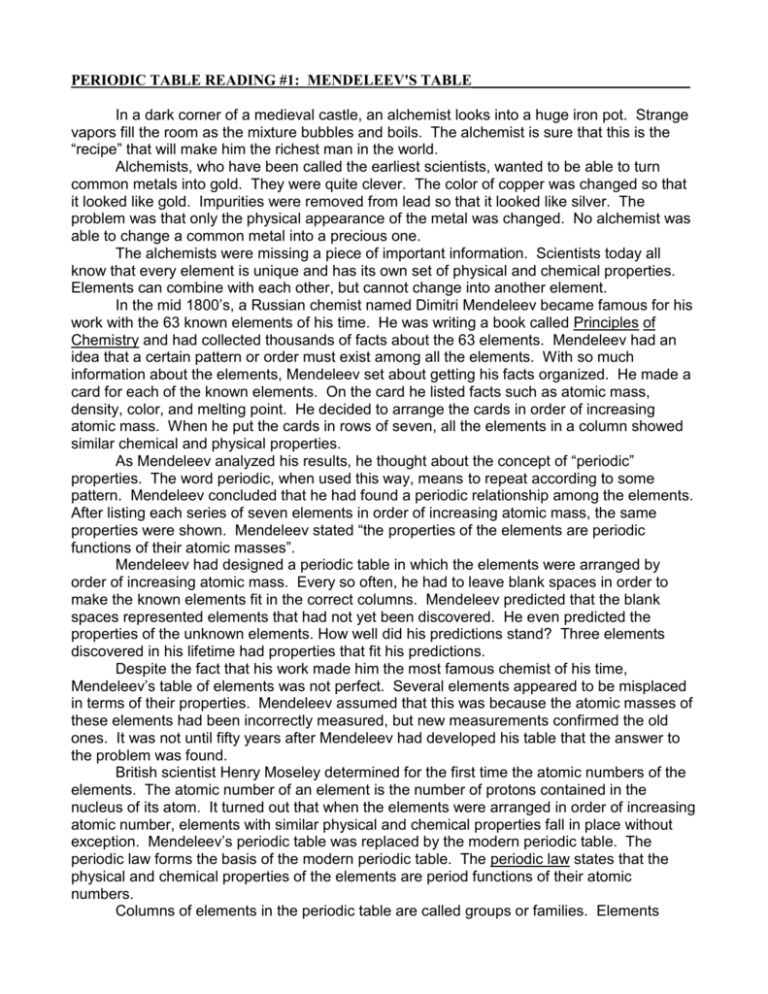
PERIODIC TABLE READING #1: MENDELEEV'S TABLE_____________________________ In a dark corner of a medieval castle, an alchemist looks into a huge iron pot. Strange vapors fill the room as the mixture bubbles and boils. The alchemist is sure that this is the “recipe” that will make him the richest man in the world. Alchemists, who have been called the earliest scientists, wanted to be able to turn common metals into gold. They were quite clever. The color of copper was changed so that it looked like gold. Impurities were removed from lead so that it looked like silver. The problem was that only the physical appearance of the metal was changed. No alchemist was able to change a common metal into a precious one. The alchemists were missing a piece of important information. Scientists today all know that every element is unique and has its own set of physical and chemical properties. Elements can combine with each other, but cannot change into another element. In the mid 1800’s, a Russian chemist named Dimitri Mendeleev became famous for his work with the 63 known elements of his time. He was writing a book called Principles of Chemistry and had collected thousands of facts about the 63 elements. Mendeleev had an idea that a certain pattern or order must exist among all the elements. With so much information about the elements, Mendeleev set about getting his facts organized. He made a card for each of the known elements. On the card he listed facts such as atomic mass, density, color, and melting point. He decided to arrange the cards in order of increasing atomic mass. When he put the cards in rows of seven, all the elements in a column showed similar chemical and physical properties. As Mendeleev analyzed his results, he thought about the concept of “periodic” properties. The word periodic, when used this way, means to repeat according to some pattern. Mendeleev concluded that he had found a periodic relationship among the elements. After listing each series of seven elements in order of increasing atomic mass, the same properties were shown. Mendeleev stated “the properties of the elements are periodic functions of their atomic masses”. Mendeleev had designed a periodic table in which the elements were arranged by order of increasing atomic mass. Every so often, he had to leave blank spaces in order to make the known elements fit in the correct columns. Mendeleev predicted that the blank spaces represented elements that had not yet been discovered. He even predicted the properties of the unknown elements. How well did his predictions stand? Three elements discovered in his lifetime had properties that fit his predictions. Despite the fact that his work made him the most famous chemist of his time, Mendeleev’s table of elements was not perfect. Several elements appeared to be misplaced in terms of their properties. Mendeleev assumed that this was because the atomic masses of these elements had been incorrectly measured, but new measurements confirmed the old ones. It was not until fifty years after Mendeleev had developed his table that the answer to the problem was found. British scientist Henry Moseley determined for the first time the atomic numbers of the elements. The atomic number of an element is the number of protons contained in the nucleus of its atom. It turned out that when the elements were arranged in order of increasing atomic number, elements with similar physical and chemical properties fall in place without exception. Mendeleev’s periodic table was replaced by the modern periodic table. The periodic law forms the basis of the modern periodic table. The periodic law states that the physical and chemical properties of the elements are period functions of their atomic numbers. Columns of elements in the periodic table are called groups or families. Elements PERIODIC TABLE READING #1: MENDELEEV'S TABLE_____________________________ within the same family have similar but not identical properties. Lithium (Li), sodium (Na), potassium (K), and the other members of that group are all soft silver-white shiny metals. Fluorine (F), chlorine (Cl), bromine (Br), and iodine (I) are all in the same family or group. All four elements react to form the same kinds of compounds. Each row of elements in the periodic table is called a period. The properties of the elements change greatly across any given row. However, there is a pattern as you move across the rows. The first element in a period is always a very reactive solid. It combines readily with other elements. The last element in a period is always a very inactive (inert) gas. Inert gases do not combine with other elements. The first element of period 4 is potassium (K), a very reactive solid. The last element, krypton (Kr), is an inert gas. There are seven rows or periods of elements. Periods 6 and 7 each have a row that has been separated out and placed under the main table. They are still included in the periodic table. They have been separated out to make the tables shorter so it is easier to read and print. QUESTIONS: COPY and ANSWER the following questions on separate paper. 1. Why couldn’t the alchemists change copper into gold? 2. When did Dimitri Mendeleev become famous for his work with elements? 3. What property did Mendeleev use to arrange his chart of elements? 4. Why was Mendeleev’s chart called a “periodic” table? 5. Why did Mendeleev leave blank spaces in his periodic table? 6. How was Mendeleev’s periodic table incorrect? 7. What did Henry Moseley determine 50 years after Mendeleev had developed his table? 8. How did Moseley’s discovery change the periodic table? 9. State the periodic law we use today. 10. What are vertical columns of elements on the periodic table called? 11. How are these columns similar? 12. What are horizontal rows of elements on the periodic table called? 13. Elements on the left side of a row always have what properties? 14. Elements on the right side of a row always have what properties? 15. Chlorine is often added to swimming pool water to kill germs. According to the periodic law, what other element might be used to do the same job? 16. Why are parts of periods 6 and 7 at the bottom of the periodic table? 17. How could the periodic table be used to predict the properties of an element?

